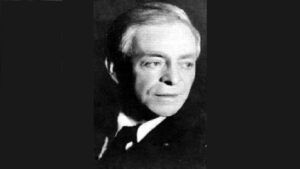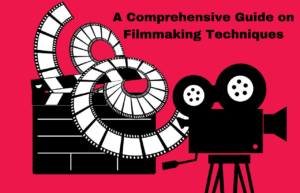Filmmaking Techniques: A Comprehensive Guide
Throughout this blog, we will explore various filmmaking techniques in detail, providing practical insights and real-world examples to help you master the craft of filmmaking.

A Comprehensive guide on filmmaking techniques

Welcome to our comprehensive guide on filmmaking techniques! In this blog, we delve deep into the intricate world of filmmaking, exploring a wide range of techniques and strategies employed by filmmakers to bring their stories to life on the silver screen.
Filmmaking is a multifaceted art form that requires a combination of technical expertise, creative vision, and storytelling prowess. From the fundamentals of cinematography and lighting to the nuances of editing and sound design, every aspect of filmmaking contributes to the overall cinematic experience.
Throughout this blog, we will explore various filmmaking techniques in detail, providing practical insights and real-world examples to help you master the craft of filmmaking. Whether you’re a budding filmmaker looking to learn the basics or an experienced director seeking to refine your skills, our guide is designed to equip you with the knowledge and tools you need to succeed in the world of filmmaking.
Join us on this immersive journey into the world of filmmaking techniques, where we unravel the secrets behind creating compelling and captivating films that resonate with audiences worldwide.
Chapter 1: Crafting Compelling Narratives Through Visual Storytelling
Visual storytelling is the art of conveying a narrative using primarily visual elements such as imagery, composition, and camera movements. It’s a powerful tool that allows filmmakers to communicate emotions, themes, and messages effectively to their audience without relying heavily on dialogue or exposition.
To tell a compelling story through visual storytelling, filmmakers must first understand the story they want to tell and the emotions they want to evoke in their audience. This involves careful planning and pre-visualization to determine the visual style, tone, and pacing of the film.
One key aspect of visual storytelling is the use of symbolism and metaphor to convey deeper meaning. By incorporating visual motifs and recurring imagery, filmmakers can enrich the narrative and engage viewers on a subconscious level.
Additionally, framing and composition play a crucial role in visual storytelling. The way a scene is framed can influence how the audience perceives the characters and their relationships, as well as the overall mood of the film. Directors often use framing techniques such as close-ups, wide shots, and point-of-view shots to create visual interest and draw attention to important elements within the frame.
Furthermore, visual storytelling relies heavily on the use of visual effects and camera techniques to enhance the storytelling experience. From elaborate camera movements to dynamic editing choices, every visual element should serve the story and contribute to its overall impact.
Overall, mastering the art of visual storytelling requires a deep understanding of storytelling principles, visual aesthetics, and technical filmmaking skills. By combining these elements effectively, filmmakers can create powerful and memorable cinematic experiences that resonate with audiences long after the credits roll.
Chapter 2: Use Experienced and Talented Cast & Crew
The success of any film production relies heavily on the talent and expertise of its cast and crew. From actors to cinematographers, production designers to editors, every member of the team plays a crucial role in bringing the director’s vision to life on screen.
When assembling a cast and crew for a film, it’s essential to prioritize experience and skill. Experienced actors bring depth and authenticity to their performances, while seasoned crew members ensure that every aspect of the production runs smoothly and efficiently.
In addition to experience, chemistry and collaboration are also key factors to consider when choosing a cast and crew. A cohesive team that works well together can elevate the quality of the film and enhance the overall creative process.
Moreover, working with experienced professionals can also provide valuable mentorship and learning opportunities for up-and-coming filmmakers. By surrounding themselves with talented individuals who are passionate about their craft, directors can expand their own skills and knowledge base, ultimately leading to a stronger and more successful film.
In conclusion, using an experienced cast and crew is essential for any filmmaker looking to create a high-quality film. By prioritizing talent, experience, and collaboration, directors can ensure that their vision is brought to life with precision, creativity, and excellence.
Chapter 3: Use Art and Science In Production Design
Production design is a crucial aspect of filmmaking that encompasses the visual elements of a film, including sets, costumes, props, and overall aesthetics. It’s the art of creating the world in which the story takes place and plays a significant role in shaping the look and feel of the film.
The production design process typically begins with extensive research and conceptualization to establish the visual style and tone of the film. This involves studying the script, discussing ideas with the director, and collaborating with other key creatives to develop a cohesive vision for the project.
Once the overall concept is established, the production designer works closely with various departments to bring the vision to life. This includes working with the art department to design and construct sets, collaborating with the costume designer to create costumes that reflect the characters and time period, and sourcing or creating props that enhance the authenticity of the world.
Throughout the production process, the production designer oversees the implementation of the design elements, ensuring that they align with the director’s vision and contribute to the overall storytelling experience. This involves meticulous attention to detail, creative problem-solving, and effective communication with the rest of the crew.
In conclusion, production design plays a vital role in shaping the visual identity of a film and bringing the director’s vision to life on screen. By collaborating with talented professionals and paying attention to every detail, filmmakers can create immersive and memorable worlds that captivate audiences and enhance the storytelling experience.
Chapter 4: Filming the Story
Filming the story is the process of capturing the visual and auditory elements of a film on camera. It involves selecting the appropriate equipment, setting up shots, directing actors, and overseeing the technical aspects of the production to ensure that the director’s vision is realized on screen.
One of the key considerations when filming a story is choosing the right camera equipment and lenses to achieve the desired look and feel. Different cameras and lenses offer unique capabilities and aesthetics, and selecting the right ones can have a significant impact on the visual style of the film.
In addition to equipment selection, framing and composition are also crucial aspects of filming a story. The way a scene is framed can influence the audience’s perception of the characters and their relationships, as well as the overall mood of the film. Directors often use framing techniques such as close-ups, wide shots, and point-of-view shots to create visual interest and draw attention to important elements within the frame.
Furthermore, directing actors is an essential part of filming a story, as their performances bring the characters to life and drive the narrative forward. Directors must communicate their vision clearly to the actors and provide guidance and feedback to help them deliver authentic and compelling performances.
Overall, filming a story requires careful planning, attention to detail, and effective collaboration between the director, cast, and crew. By selecting the right equipment, framing shots thoughtfully, and directing actors skillfully, filmmakers can capture the essence of the story and create a cinematic experience that resonates with audiences.
Chapter 5: Camera Techniques in Film for Cinematic Excellence
Camera techniques are the tools and methods filmmakers use to capture images and convey meaning through visual storytelling. From basic camera movements to advanced techniques, understanding and mastering these techniques are essential for creating dynamic and engaging visuals in film.
One of the fundamental camera techniques in film is the use of different types of shots, including wide shots, medium shots, and close-ups. Each type of shot offers a unique perspective and can be used to convey different emotions and messages to the audience.
In addition to static shots, filmmakers often use camera movement to add energy and dynamism to their visuals. Techniques such as panning, tilting, and tracking shots can create a sense of movement and immersion, drawing the audience into the world of the film.
Furthermore, filmmakers also utilize framing and composition to create visually striking images. The rule of thirds, leading lines, and depth of field are just a few compositional techniques that can be used to enhance the visual impact of a shot and guide the viewer’s eye.
Moreover, advanced camera techniques such as steadicam shots, crane shots, and aerial shots can add a cinematic flair to a film and create memorable visuals that leave a lasting impression on the audience.
Overall, mastering camera techniques is essential for filmmakers looking to create visually compelling and immersive films. By understanding the principles of shot composition, camera movement, and framing, directors can effectively convey their vision and create a cinematic experience that resonates with audiences.
Chapter 6: Illuminating the Screen Using Lighting Techniques
Lighting is a fundamental element of filmmaking that has a profound impact on the mood, atmosphere, and visual aesthetic of a film. Understanding and mastering lighting techniques is essential for creating visually striking and emotionally resonant images on screen.
One of the key lighting techniques used in filmmaking is three-point lighting, which consists of a key light, fill light, and backlight. This setup allows filmmakers to control the intensity, direction, and quality of light in a scene, creating depth and dimensionality in the image.
In addition to three-point lighting, filmmakers also use natural light and practical lights to create a sense of realism and authenticity in their visuals. By carefully manipulating natural light sources or incorporating practical lights into the scene, filmmakers can enhance the believability of the environment and make the audience feel immersed in the world of the film.
Furthermore, lighting can also be used creatively to evoke emotions and enhance storytelling. Techniques such as chiaroscuro lighting, where strong contrasts between light and shadow are used to create dramatic effects, can add depth and complexity to a scene, while soft lighting can create a more romantic or ethereal atmosphere.
Moreover, filmmakers also use color temperature and color gels to manipulate the mood and tone of a scene. Warm colors like red and orange can evoke feelings of warmth and intimacy, while cool colors like blue and green can create a sense of calm or unease.
Overall, mastering lighting techniques is essential for filmmakers looking to create visually striking and emotionally resonant images on screen. By understanding the principles of light intensity, direction, and color, directors can effectively manipulate light to enhance the storytelling experience and create cinematic visuals that leave a lasting impression on the audience.
Chapter 7: Craft the Narrative Using Editing Techniques
Editing is the process of selecting, arranging, and manipulating visual and auditory elements to create a cohesive and engaging narrative in film. It’s a crucial stage of post-production that requires careful attention to detail, creative problem-solving, and a deep understanding of storytelling principles.
One of the key editing techniques used in filmmaking is continuity editing, which aims to create a seamless flow of action and maintain spatial and temporal consistency between shots. This involves matching eyelines, movement, and screen direction to ensure that the audience can follow the action without being distracted by inconsistencies.
In addition to continuity editing, filmmakers also use various techniques such as jump cuts, montages, and parallel editing to create rhythm and pacing in their films. Jump cuts can be used to create a sense of disorientation or emphasize a character’s emotional state, while montages can condense time and convey information efficiently.
Furthermore, filmmakers also use editing to enhance the emotional impact of a scene through techniques such as pacing, rhythm, and juxtaposition. By manipulating the timing and duration of shots, directors can build tension, create suspense, or evoke specific emotional responses from the audience.
Moreover, sound editing is an essential aspect of the editing process that involves selecting and manipulating audio elements such as dialogue, music, and sound effects to enhance the storytelling experience. Sound can be used to create atmosphere, convey emotions, and immerse the audience in the world of the film.
Overall, mastering editing techniques is essential for filmmakers looking to create a cohesive and engaging narrative in film. By understanding the principles of continuity editing, pacing, and rhythm, directors can effectively manipulate visual and auditory elements to create a cinematic experience that resonates with audiences.
Chapter 8: Select the Perfect Music
Music is a powerful storytelling tool that can enhance the emotional impact of a film and elevate the overall cinematic experience. Choosing the right music for a film is essential for setting the mood, establishing the tone, and reinforcing the narrative themes.
One of the key considerations when selecting music for a film is matching the style and genre of the music to the tone and genre of the film. Whether it’s a dramatic orchestral score, a lively jazz soundtrack, or a contemporary pop song, the music should complement the visuals and enhance the storytelling experience.
In addition to style and genre, filmmakers also consider the emotional resonance of the music and how it aligns with the themes and characters of the film. A well-chosen piece of music can evoke specific emotions in the audience and deepen their connection to the story and characters.
Furthermore, filmmakers also pay attention to the timing and placement of music within the film. Whether it’s a dramatic crescendo during a pivotal moment or a subtle underscoring of a character’s internal struggle, the music should enhance the narrative and contribute to the overall emotional arc of the film.
Moreover, composers and music supervisors play a crucial role in selecting and creating music for a film. Collaborating closely with the director, they work to understand the director’s vision and create a custom score or select pre-existing music that enhances the storytelling experience.
Overall, using appropriate music is essential for filmmakers looking to create a cohesive and emotionally resonant cinematic experience. By selecting music that aligns with the tone, themes, and emotional arc of the film, directors can enhance the storytelling experience and create a lasting impact on the audience.
Chapter 9: Elevating the Narrative Through Sound Design
Sound is an often-overlooked but essential aspect of filmmaking that can have a profound impact on the audience’s perception and emotional response to a film. While visuals are important for creating a compelling visual narrative, sound can enhance the overall cinematic experience and create a sense of immersion and realism.
One of the key ways in which sound can enhance a film is by creating atmosphere and establishing the tone of a scene. Whether it’s the ambient sounds of a bustling city street or the eerie silence of a deserted forest, sound can set the mood and transport the audience into the world of the film.
In addition to atmosphere, sound can also be used to convey information and enhance storytelling. Dialogue, sound effects, and music can all contribute to the narrative by providing context, conveying emotion, and guiding the audience’s attention to important plot points.
Furthermore, sound design is an essential aspect of filmmaking that involves the creation and manipulation of sound elements to enhance the auditory experience. From Foley artists creating realistic sound effects to composers crafting custom scores, sound design adds depth and texture to the film’s audio landscape.
Moreover, sound mixing and editing play a crucial role in ensuring that the various sound elements blend seamlessly together and enhance the overall storytelling experience. By balancing dialogue, music, and sound effects, sound mixers can create a dynamic and immersive auditory experience that complements the visuals and enhances the emotional impact of the film.
Overall, sound is an essential aspect of filmmaking that can have a profound impact on the audience’s perception and emotional response to a film. By paying attention to sound design, mixing, and editing, directors can create a cohesive and immersive cinematic experience that resonates with audiences long after the credits roll.
Chapter 10: Apply Special Effects and Advanced Techniques
Special effects and advanced filmmaking techniques are tools used by filmmakers to create visually stunning and technically complex scenes that would be difficult or impossible to achieve using traditional filmmaking methods. From computer-generated imagery (CGI) to practical effects, these techniques allow directors to push the boundaries of visual storytelling and create truly immersive cinematic experiences.
One of the most common special effects techniques used in filmmaking is CGI, which involves creating digital elements that are integrated into live-action footage. CGI can be used to create realistic creatures, environments, and visual effects that enhance the visual spectacle of a film and transport the audience into fantastical worlds.
In addition to CGI, filmmakers also use practical effects to create realistic and tangible elements on set. From elaborate prosthetics and makeup to intricate miniature models and animatronics, practical effects add a sense of realism and authenticity to the film and can be particularly effective in creating visceral and tactile experiences for the audience.
Furthermore, advanced filmmaking techniques such as motion capture, green screen compositing, and 3D stereoscopy are used to create immersive and dynamic visual experiences that push the boundaries of traditional filmmaking. These techniques allow directors to create intricate and visually stunning scenes that transport the audience into new worlds and dimensions.
Moreover, directors also use advanced camera techniques such as slow motion, time-lapse, and aerial cinematography to create visually striking and dynamic sequences that capture the imagination and leave a lasting impression on the audience.
Overall, special effects and advanced filmmaking techniques are powerful tools that allow directors to create visually stunning and technically complex scenes that push the boundaries of visual storytelling. By combining these techniques with a strong narrative and compelling characters, filmmakers can create truly immersive cinematic experiences that captivate audiences and leave a lasting impact on the world of cinema.
Chapter 11: Conclusion
In conclusion, our exploration of filmmaking techniques has provided a comprehensive overview of the intricacies involved in crafting compelling cinematic experiences. From the foundational elements of visual storytelling to the utilization of experienced cast and crew, each aspect plays a vital role in shaping the narrative and engaging audiences on a profound level.
Visual storytelling emerged as a central theme throughout our discussion, highlighting the importance of conveying narratives through imagery, composition, and camera techniques. By mastering the art of visual storytelling, filmmakers can evoke emotions, convey messages, and immerse viewers in the world of their stories.
The significance of employing experienced cast and crew cannot be overstated, as they bring a wealth of talent, expertise, and creative insight to the filmmaking process. Collaborating with seasoned professionals enhances the quality of the production and elevates the director’s vision to new heights.
Production design emerged as a crucial element in creating immersive cinematic worlds, while camera techniques, lighting techniques, and editing techniques added depth and visual interest to the storytelling. Additionally, the strategic use of appropriate music and sound over visuals further enhanced the emotional impact of the narrative.
Special effects and advanced filmmaking techniques provided filmmakers with the tools to push the boundaries of visual storytelling, creating visually stunning and technically complex scenes that captivate audiences.
In essence, our exploration of filmmaking techniques underscores the multifaceted nature of the craft and the endless possibilities for creativity and innovation. By mastering these techniques and employing them thoughtfully, filmmakers can create cinematic experiences that resonate with audiences long after the credits roll.
As we conclude our journey into the world of filmmaking techniques, we invite aspiring filmmakers and seasoned directors alike to continue exploring, experimenting, and honing their craft. With dedication, passion, and a commitment to storytelling excellence, the possibilities for creating impactful and memorable films are limitless.
Top filmmaking institutes in India:
- Film and Television Institute of India (FTII), Pune
- Satyajit Ray Film & Television Institute (SRFTI), Kolkata
- National Institute of Design (NID), Ahmadabad
- Whistling Woods International, Mumbai
- Ramesh Sippy Academy of Cinema and Entertainment, Mumbai
- Asian Academy of Film (AAFT) University, Raipur
- L.V. Prasad Film & TV Academy, Chennai
- Center for Research in Art of Film and Television (CRAFT), Delhi
- The ICE Institute, Mumbai
- Kalapurnam Institute Of Visual Effects & Animation, Ahmadabad
Please also read: Sidhu Moose Wala: A Musical Maverick’s Journey






